
More advanced and multi-functionalized CG/VR solutions
Day2 (Nov. 19th, 2020) started with a presentation named "The latest features of Shade 3D and future prospects, utilization of Suite Chidori engine" by a FORUM8 staff. He introduced the latest functions of Shade3D and the real-time linkage with UC-win/Road and did a demonstration of the IFC input/output and BIM/CIM design check tool corresponding to the guideline by the MLIT. As for the newest feature of Suite Chidori Engine, he explained the post effect library. In addition to showing the demonstration using sample data, he talked about the programming PC based on the GIGA School Concept and TV commercials that Pakkun appears.
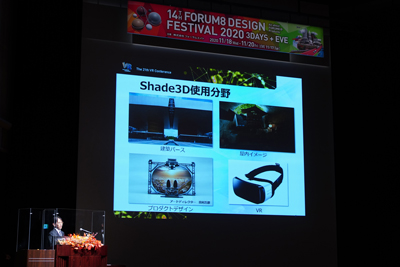 |
|
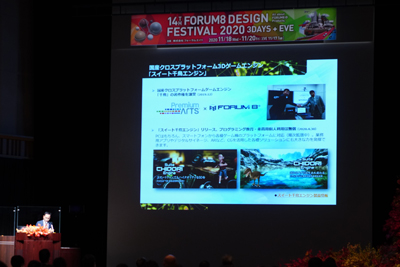 |
| Shade3D used in various ways |
|
New features of Suite Chidori Engine |

Pay attention to new value generated from the AI technologies and the latest expressions
"The 6th State of the Art Technologies in Expression Association / Latest Technology Art Sessions" was held in the former half of Day2 afternoon. First of all, Associate Professor Toshihiko Yamasaki from Graduate School of Information Science and Technology, The University of Tokyo gave a special lecture named "New experiences and values created by AI". The theme of the lecture was the "attractive engineering" using the image recognition, AI, and deep learning. He talked about his study on things and services made by combining several data which appeal to human sensibilities and emotions such as impressiveness and attractiveness. A lot of guests at the venue were attracted by one of his case studies of increasing the number of "Like" on SNS.
Next, we announced The 4th Hagura Award and held the award ceremony. This year, the highest number of works ever were recommended, and total of 13 works including 1 Hagura Award, 1 FORUM8 Award, 4 Encouraging Award, and 7 Nominate Award were selected.
"Automatic creation of photo-realistic singer and dancer characters from one image" by Department of Applied Physics, School of Advanced Science and Engineering, Waseda University was selected as the enterprize award "FORUM8 Award". A character that sings and dances can be created automatically by combining a dance motion capture technology and a technology to create a high-definition face model and realistic facial expression from a face photo and singing voice.
The Hagura Award was given to "Noto Hiba Speaker" by Hokuriku Advanced Sound Engineering Lab. This was the first work expressed by only sound. This innovative speaker drive circuit technology drives the speaker unit with current, predicts the voice coil speed from the detected electromotive force and current signal by high-speed analog signal processing, and constitutes the feedback system. Since it is sensorless, it has a high-speed response and can be applied to commonly used speaker units.
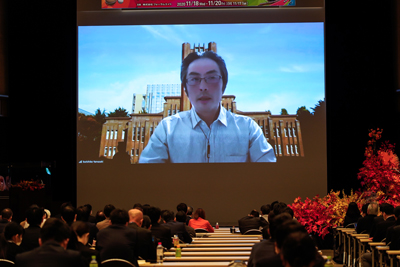 |
|
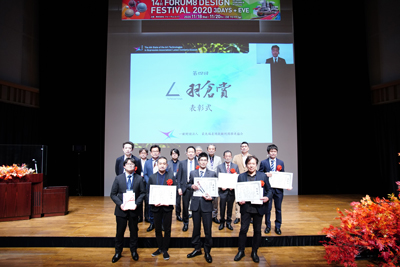 |
| Special lecture by Assoc. Prof. Toshihiko Yamasaki |
|
Award winners of Hagura Award |

A lot of UC-win/Road researches utilizing advanced technology including image recognition
At the International VR Symposium, "W16", the group of researchers from various fields in universities all over the world present research results of the workshop held every summer. Lead by Prof. Yoshihiro Kobayashi from Arizona State University, this project marked the 13th anniversary. Due to the COVID-19 crisis, both of summer workshop and International VR Symposium were held online this year. The researchers presented many unique research developments seeking advanced utilization of UC-win/Road.
| Virtual & Interactive Museums Real Estates Collaborative Design |
|
Flexible Traffic Lights |
Prof. Amar Bennadji, Robert Gordon University
|
|
Prof. Kostas Terzidis, Tongji University Design Creative Academy |
 |
|
 |
Under the influence of covid-19, he suggested the use of interactive virtual tour application on the Web as part of architectural design education. He wants to use it at exhibitions, housing exhibitions, and sightseeing spots in the future.
|
|
His study is on the traffic control by using AI technologies and neural network. Information was regressed from a mathematical probability approach such as permutation to recognize and judge, and he verified what kind of traffic control is comfortable for the driver. |
|
|
|
| Visual Voxel Heatmap Generation |
|
GANs and Latent Space |
| Marc Aurel Schnabel, Victoria University of Wellington |
|
Prof. Marcos Novac, University of California |
 |
|
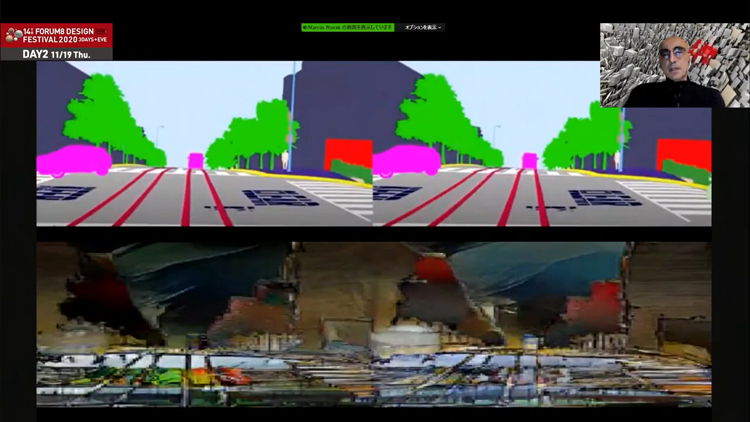 |
| He collected 3D data by using the voxel heat map, and based on some main points, he built a system that analyze human behavior. Data of vector, time, and position obtained from eye-tracking data enables the quantitative analysis. |
|
This GAN extracts elements contained in information such as images by deep learning and generates a new space from them. Segmentations that recreate characters and change scenery style are also available.
|
|
|
|
| VR Immersive Experience Engaging Five Senses |
|
The colors of point-cloud |
| Prof. Thomas Tucker, Virginia Tech |
|
Prof. Dongsoo Choi, Virginia Tech |
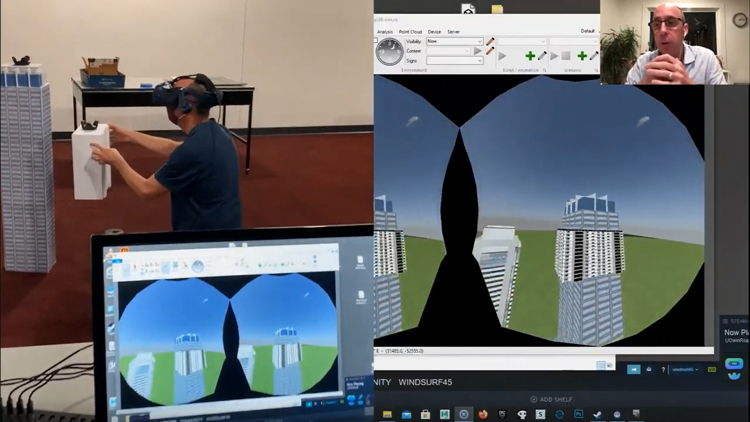 |
|
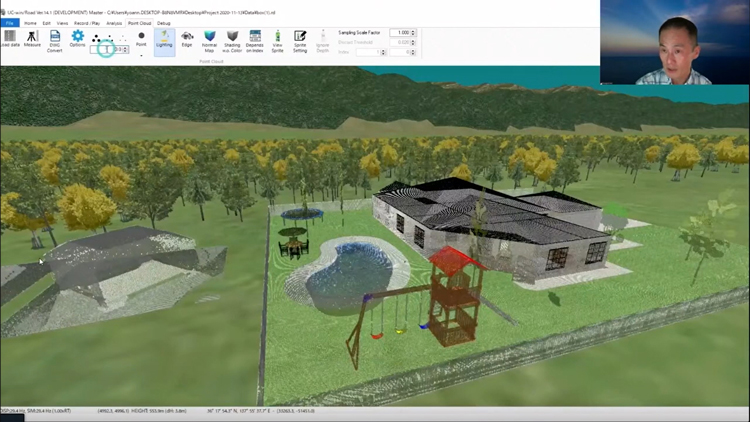 |
A real model created from a 3D model was linked with UC-win/Road by using the VIVE tracker sensor. He created a realistic city by creating paper models using texturing and by stacking up buildings.
|
|
Point cloud were visualized with a three-dimensional effect by etching and shader. Using point cloud data without color and brightness information, the analysis was performed by changing the point cloud size and the numerical value of the data itself to change the lighting and color. |
|
|
|
| HVRI for Architecture Modeling Design within Immersive Virtual Reality |
|
Assessing VR toward preventing VR sickness |
| Prof. Sky Lo Tian Tian, Harbin Institute of Technology, Shenzhen |
|
Prof. Tomohiro Fukuda, Graduate School of Osaka University |
 |
|
 |
| This is an AR system that allows users to remotely control UC-win/Road data mapping projected on the screen fixed on the table top by using Hololens and gestures. |
|
To ease the VR sickness, he expanded the video shader. From video data, a heat map can be created quickly in real time using the acceleration and absolute speed. The blur effect by shader was also explained. |
|
|
|
| Artistic Filters on Point Clouds in UC-win/Road |
|
Car accident Simulation & Visualization The advantage of VR and UC-win/Road |
| Prof. Rebeka Vital, Shenkar College of Engineering, Design and Art |
|
Prof. Ruth Ron, Miami, School of Architecture
|
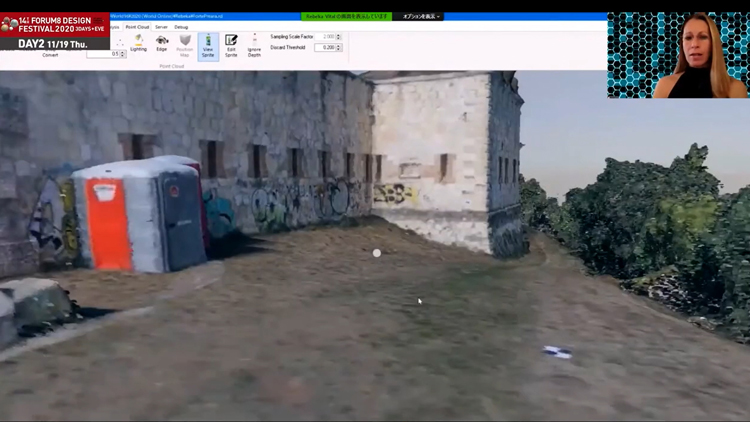 |
|
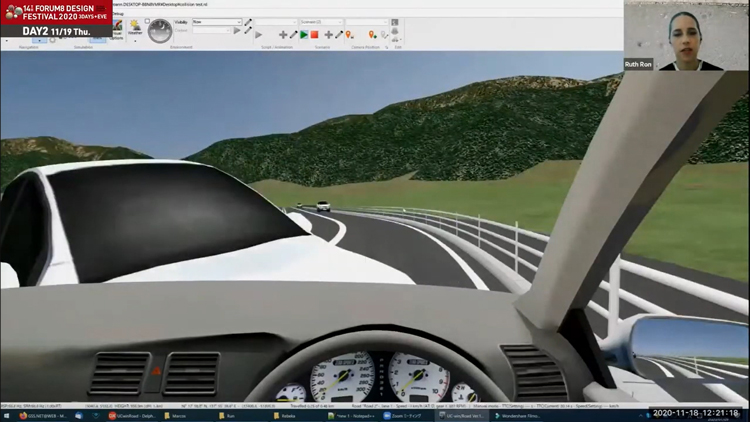 |
She customized a shader and developed a function to apply filters to point cloud. Particles can be converted to hexa, brushing stroke, crystal, and spiral.
|
|
The impact at the time of collision of car and motorbike was visualized by physical simulation. The driving simulation under bad visibility like mist and rain was also possible. Additional tests such as the snowy weather are also planned. |
|
|
|
| 5D Development system UC-win/Road Sustainable Planning and Design |
|
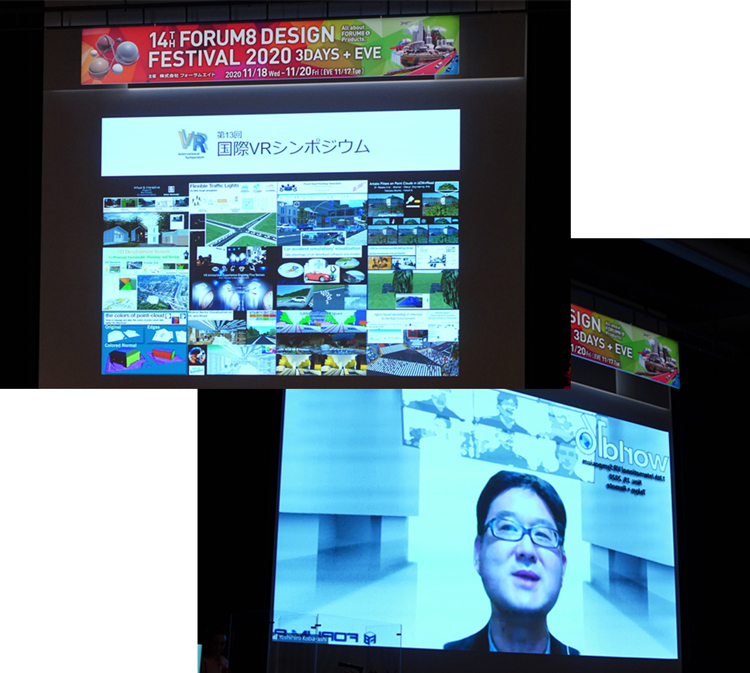
Prof. Yoshihiro Kobayashi, the leader
of World16 served as a host. |
| Prof. Paolo Fiamma, University of Pisa |
|
 |
|
| This is a research to utilize UC-win/Road for making a sustainable urban development. Using IFC data, the system computes time and cost from the quantity of heavy machine, road, ramp, and tree required for infrastructure arrangement and proposes data. |
|
|
|
|

Many highly complete systems including technologies related to autonomous driving and cooperation with sensor model
|
The 8th CPWC is a competition that students around the world compete their programming skills by using the development kit for UC-win/Road, VR-Cloud®, and Suite Chidori Engine. Among 27 entries from all over the world, 7 works were nominated. We held the final judgment and award ceremony by online live focusing on the attendees from overseas.
As for the presentations of each nominee, the chief of committee Tomohiro Fukuda commented that many of works and presentations were made in a very high completion level despite this COVID-19 crisis. As we can see in this comment, all juries gave high evaluation to each work. Seeing from the technology side, many works were built by the combination of autonomous driving, AI, and sensor technology, and the realization possibility in the future seemed to be also high.
The Grand Prix was given to "DrEyeVer: Detecting Objects on Driver’s Focus of Attention for Intelligent Vehicle" by KaAI (Kookmin University, Korea). This system combines the UC-win/Road driving simulator and driver's eye-tracking data obtained with the wearable eye tracker, and it alerts when the driver is not aware of vehicles around the vehicle in operation. Prof. Fukuda said "The total level was high as seen in the integration technology in addition to the use of driver's view data and eye-tracking".
|
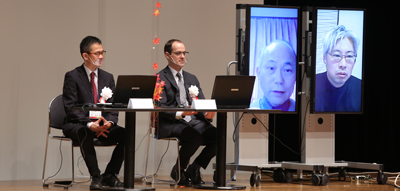 |
| Judges (from the left): Prof. Tomohiro Fukuda, Mr. Yoann Pencreach, Prof. Makoto Sato, Prof. Taro Narahara |
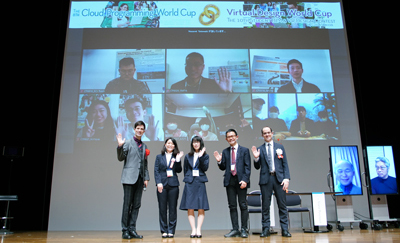 |
| Award winners |
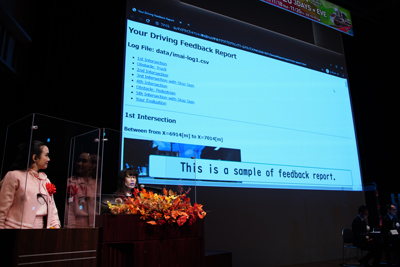 |
|
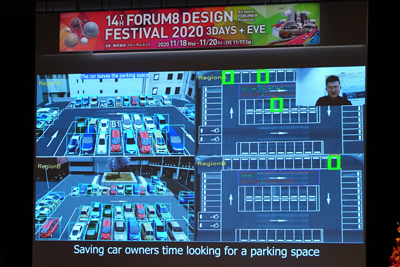 |
| Presentations in a hybrid style (Left: live / Right: online) |
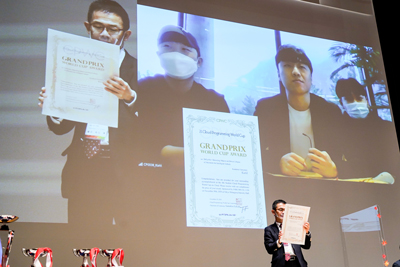 |
|
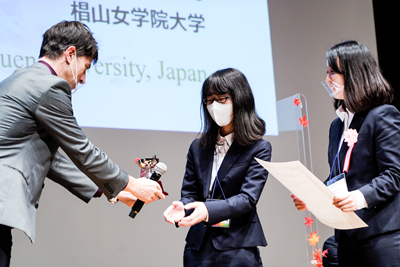 |
| Award ceremony (Left: online / Right: live) |

Lively online award ceremony with participants from all over the world
|
The theme of the 10th VDWC was 'Future Mobility Lifestyle in Kalimantan, Indonesia's New Capital known as the "Forest City"'. About the students' suggestions for the future sustainable city such as the advanced mobility to decrease traffic jam and the entertainment combining nature and digital, the committee chair Yasushi Ikeda highly appreciated their attitude toward solving the current pandemic situation.
FutureForestCity FamilyLab (Kanazawa University, Japan) that won the Grand Prix designed a smart, sustainable, and eco-friendly city. The main concept is the ubiquitous wireless charging for the special-designed drone named Abee and other flight vehicles. The juries appriciated the mechanism that Abee and holographic projection technology built the immersive augmented reality (AR) environment to assist daily life, and the integrated ideas of the reusable energy such as sunshine energy, bio energy, and wind energy.
|
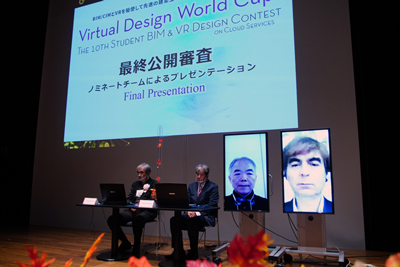
Juries (from the left) Prof. Yasushi Ikeda, Prof. Masaru Minagawa, Prof. C. DAVID TSENG, Prof. Kostas Terzidis |
| This was the first trial of connecting the award winners all over the world online and holding presentation, final judgment, and even award ceremony. On the screen of Animal Crossing Rainforest Vein (National University of Kaohsiung, Taiwan) which won the Excellence Award, we could see a lot of friends of the team members were cheering the team with full of enthusiasm. |
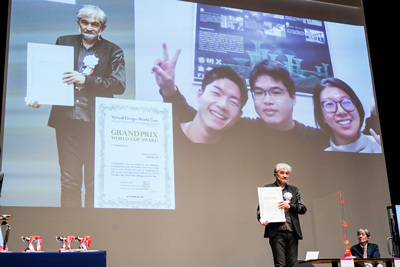 |
|
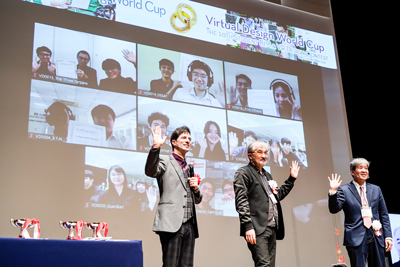 |
| Grand Prix |
|
Award winners |

|
Free and joyful VR expressions are created one after another
FORUM8 holds "Junior Software Seminar" for elementary and junior high school students in every long vacation in winter, spring, and summer. Works created by participants in a year are awarded at Design Festival every year. The participants gathered at the hall and online, and Pakkun was also on the stage as the commentator. A total of 25 works, the highest ever, were commended this year. 12 works were awarded to Gold Prize, 10 to Silver Prize, and 3 to Bronze Prize.
|
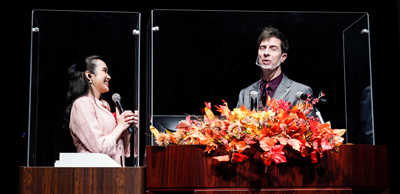
Host Ms. Kaltida Tada (Left) and presenter Mr. Patrick Harlan |
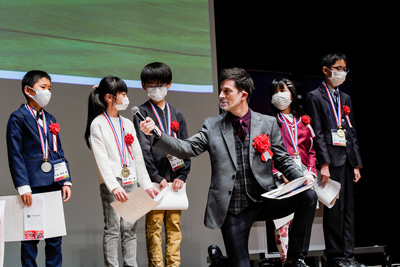 |
|
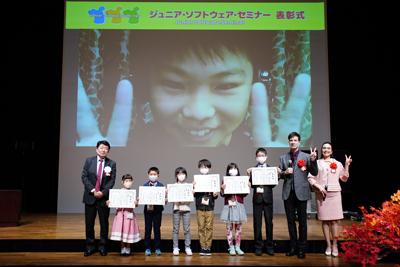 |
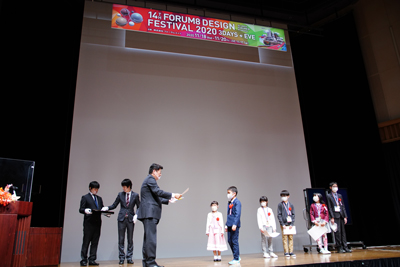 |
|
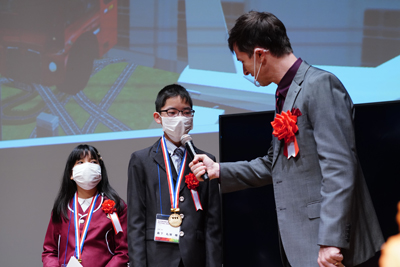 |
| Award ceremony and interview |
|
|
|





































